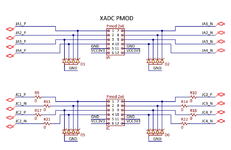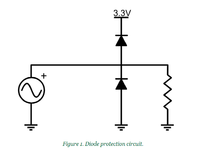engr_joni_ee
Advanced Member level 3
Hi, I just found the attached schematics of ZYBO development board. There are diodes connected to the I/O pin headers. I am trying to understand their role. I guess these diodes only protect the ZYNQ I/O from -ve voltage, for example when the applied signal is negative and goes below the ground level then these diodes will conduct in forward and project the I/O for ZYNQ. What will be the voltage across the diode and the ZYNQ I/O, would it be - 0.7 V ?
How about protecting the upper end, if the applied signal goes above VCC3V3 ?
How about protecting the upper end, if the applied signal goes above VCC3V3 ?

